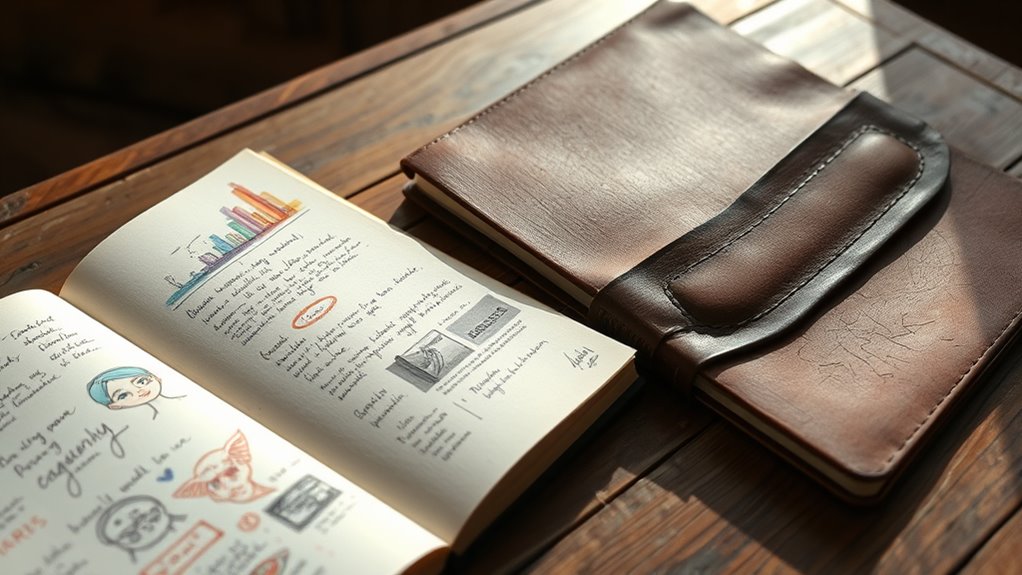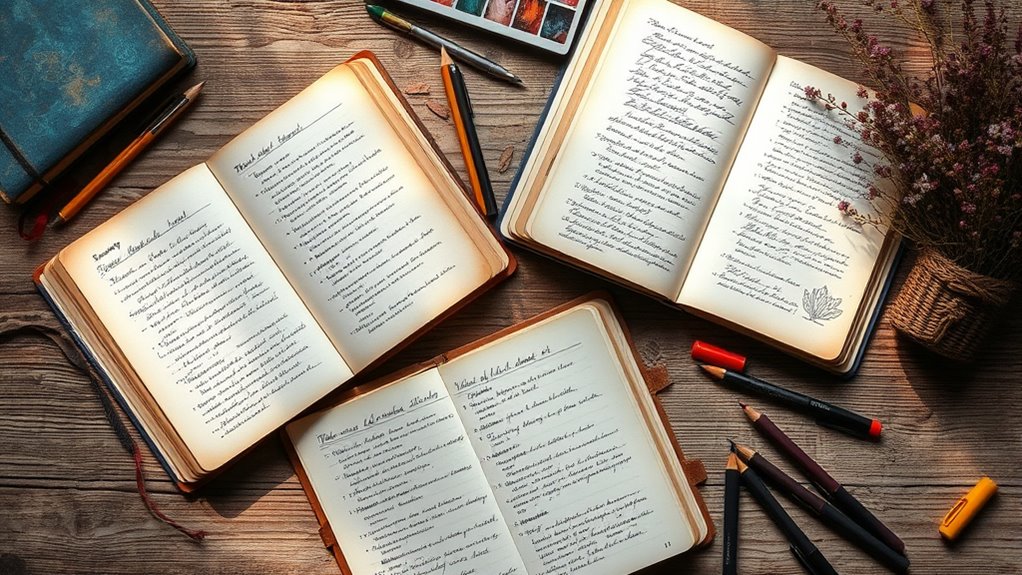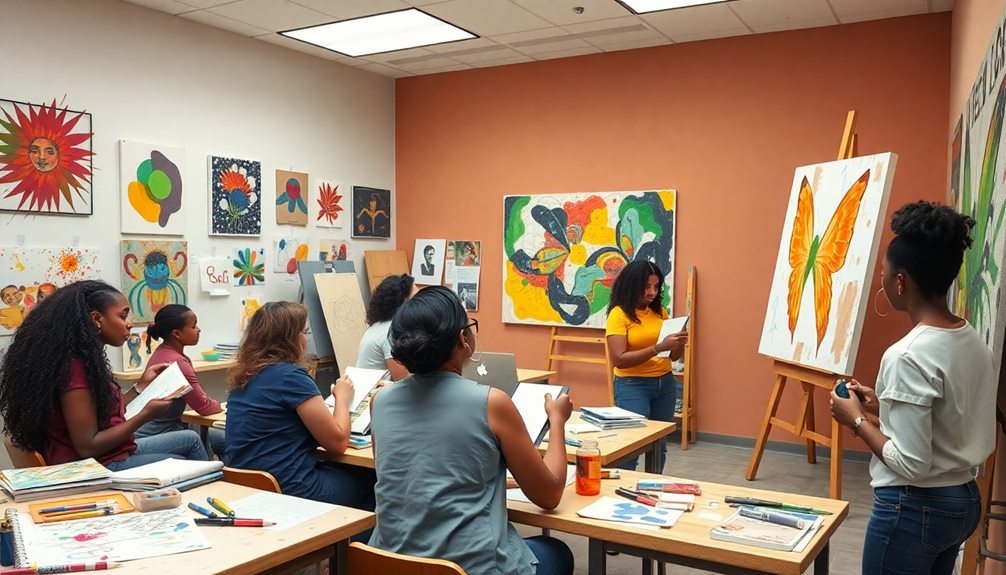Maintaining a daily sketchbook or journal helps you develop a consistent creative habit that fuels growth and self-awareness. Simple tools like notebooks, pencils, and pens make it easy to capture ideas, observations, and emotions as they happen, without pressure for perfection. Regular reflection reveals patterns and sparks new inspiration, turning your entries into a personal archive of progress. Keep exploring these practices, and you’ll discover how they can transform your artistic journey over time.
Key Takeaways
- Maintaining a daily sketchbook fosters consistent creative exploration and helps track artistic growth over time.
- Using simple tools and minimal routines makes daily practice accessible and sustainable.
- Regular reflection on sketches and notes deepens understanding and reveals recurring themes or patterns.
- Emphasizing honesty and experimentation encourages innovation and reduces fear of imperfection.
- Building a personal archive of daily entries boosts motivation and provides valuable insights into emotional and artistic development.

A sketchbook or journal can become your most trusted creative companion, capturing ideas, observations, and emotions as they happen. When you make it a habit to record your thoughts and visuals daily, you open yourself to consistent artistic exploration. This practice isn’t just about drawing or writing; it’s a way to engage with your inner world and develop your skills over time. You’ll find that even small sketches or quick notes serve as a record of your growth and a source of inspiration. It’s important to view your sketchbook as a personal space where experimentation isn’t judged but celebrated, allowing you to push boundaries and try new techniques without fear of failure.
Incorporating daily reflection into your routine helps you stay connected to your creative process. As you revisit your entries, you’ll notice patterns, recurring themes, or areas where you feel most inspired. This reflection encourages you to ask questions about what you’ve created, what you want to explore next, or how your mood influences your work. Over time, these insights deepen your artistic exploration, making your sketchbook a mirror of your evolving perspective. The act of daily reflection also cultivates mindfulness, grounding you in the present moment and turning your sketchbook into a tool for self-awareness. It’s not about perfection but about honesty and discovery.
You don’t need elaborate supplies or a strict schedule to keep this practice alive. A simple notebook or sketchpad, some pencils or pens, and a commitment to show up daily are enough. Even five minutes a day can make a significant difference. The key is consistency—showing up regularly, even if only to jot down a quick idea or make a rough sketch. Over time, these small efforts accumulate, creating a treasure trove of visual and written reflections. This collection becomes a personal archive that documents your journey, providing motivation and insight as you progress.
Frequently Asked Questions
How Often Should I Update My Sketchbook or Journal?
You should update your sketchbook or journal regularly to build a strong habit and maintain creative consistency. Aim for daily or at least several times a week, so it becomes part of your routine. Consistent updates help you develop your skills and keep your ideas flowing. Remember, the key is to stay committed and make it a natural part of your day, even if it’s just for a few minutes.
What Are the Best Materials for Beginners?
Choosing the right art supplies for beginners is like planting seeds for your creative garden. You want simple, versatile tools that fuel your confidence and growth. Start with basic pencils, a sketchbook, and some colored pencils or pens. These beginner tips help you explore without overwhelm. Opt for quality but budget-friendly options, and remember, the best materials are those that inspire you to create every day.
Can Digital Sketchbooks Replace Physical Ones?
Digital sketchbooks offer great convenience with easy editing, instant sharing, and portability, making them appealing. However, they can’t fully replace the physical connection many artists feel when using traditional sketchbooks, which foster tactile engagement and personal touch. You might find digital tools helpful for quick ideas, but for a deeper, more personal creative experience, sticking with physical sketchbooks often provides a richer connection to your art process.
How Do I Stay Motivated to Create Daily?
Staying motivated is like keeping a fire alive—you need regular fuel. You can build creative routines by setting small, achievable goals each day, which helps turn your art into a habit. Celebrate progress, no matter how tiny, and vary your projects to stay excited. Remember, habit formation takes time, so be kind to yourself. Consistency and enjoyment are your best tools for creating daily and making creativity a natural part of your life.
Should I Focus on Quality or Quantity in My Entries?
When deciding between quality and quantity, remember that both matter. Focus on quantity to encourage technique experimentation and build your skills without pressure. Over time, you’ll develop a better sense of thematic consistency, which enhances the overall quality of your work. Keep creating daily, and you’ll naturally improve—embracing both frequent practice and thoughtful refinement as you go. Balance is key to growth and sustained motivation.
Conclusion
Embracing sketchbooks and journals transforms your daily routines into a powerful creative habit. They become your personal space to experiment, reflect, and grow. When you commit to this practice, you’ll discover your ideas flourish and your skills sharpen. So, why not ask yourself—what could you create if you dedicated just a few minutes each day? Your future self will thank you for the art and insights waiting to emerge from your daily practice.









